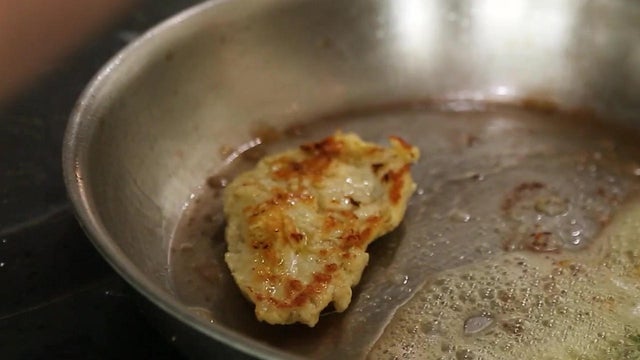Cultivated meat: Lab-grown meat without killing animals

For thousands of years, humans have slaughtered animals for meat. But Dr. Uma Valeti dreamt of a different way: eating chicken without having to kill a chicken. He figured out how to "grow" meat directly from animal cells.
It's completely different from the meat alternatives Beyond Meat or Impossible, which are made from plant-based ingredients, including vegetable proteins. "This is real meat, no compromise, made in front of you," Valeti said.
His company, Upside Foods, just received clearance from the USDA to start selling their meat, made at a production center in Emeryville, California. Here, the chicken is grown in tanks. "We'll be able to produce 50,000 to 75,000 pounds of meat every year, right away," he said.
The process begins with animal cells that have been extracted from an egg or live chicken. The cells are frozen in tiny, thimble-size vials. "All the cells that make the cut of high-quality cells make it into this seed lab," Valeti said. "And from that small amount, we can grow thousands of pounds of meat."
Coaxing the cells to multiply and grow into meat is part alchemy. In his cultivator, a turbine mixes in all the food the cells need to grow: amino acids, fats, vitamins. "The idea really is when an animal is alive, there's blood circulating, constantly something is moving around in the animal's body, touching the cells and animal's body. We're just recreating that."
Valeti said that in about 10 days, these cells have grown into chicken that's ready to cook.
What was, until recently, considered science fiction, is now, said Valeti, "like a dream come true."
Growing up in India, his big dream was to become a cardiologist, a dream he realized with the help of his parents. "They always knew my goal in life was to become a cardiologist," he said. "And I only wanted to train at the Mayo Clinic. And I trained at the Mayo Clinic. It was not easy to get there. And it was a lot of work."
Working with heart attack patients, his team set out to use stem cells to re-grow heart muscle. And he figured, why not grow animal meat in a similar way? He said, "I realized that we were raising 70 billion animals every year to feed about seven billion people. And when I looked at the environmental impact of that, it was an astronomical impact. And the amount of feed that goes to feed animals, to feed us, that equation just seemed wrong."
Livestock is responsible for an estimated one-third of all human-caused methane emissions, a potent greenhouse gas. And so, though Valeti loved to eat meat, he had become a vegetarian. But the scientist in him saw a solution. And his father, a veterinarian who loved animals, was an early supporter.
It wasn't just his dad who saw the opportunity; the very first venture capitalist that Valeti wrote to said yes. "I did not even know what a VC meant at that point!" Valeti said.
That was about eight years ago. Now, according to Bruce Friedrich, head of the non-profit Good Food Institute, which promotes alternative proteins, there's nearly $3 billion invested in more than 100 cultivated meat start-ups around the globe, such as Aleph Farms, Believer, Good Meat, Balletic Foods, Blue Nalu, and Meatable.
"Even companies like Tyson and Cargill, the two largest meat companies in the United States, they have both invested in two different cultivated meat companies," said Friedrich.
A 2022 report from Boston Consulting Group estimates that if just 11% of meat were swapped for protein alternatives (like cultivated meat) by 2035, it could have the same environmental impact as switching 95% of airplanes to renewable energy.
Friedrich said, "Cultivated meat requires a fraction of the land, requires a fraction of the water, doesn't require antibiotics in the production. This is just a whole new way of making the exact same meat that people love."
Not everyone is convinced. Critics say whether cultivated meat can cut carbon dioxide emissions depends, in part, on whether its production facilities are powered by renewable fuel. A 2023 University of California, Davis report suggests that laboratory-grown meat using pharmaceutical-grade processes (including highly refined or purified growth media) that are energy-intensive is potentially worse for the environment.
The meat industry currently has the efficiency of its large scale. Friedrich said that cultivated meat must compete on both taste and price: "Cultivated meat already competes on taste, it's already there. But it's got a ways to go before it competes on price. It needs to scale up."
Until then, it will be priced at a premium.
Aubrey got a taste of Upside's chicken, sampling a dish of chicken piccata, pan seared with white wine, lemon and butter.
"Definitely the texture of chicken," she said. "And it tastes just like chicken."
"It is chicken," Valeti said. "Chicken without killing a chicken."
You can't buy Upside's meat in grocery stores, yet. But just last weekend, Michelin-starred chef Dominique Crenn served it to customers for the first time ever in her San Francisco restaurant, Bar Crenn.
For Valeti, Upside's success is bittersweet. He lost his father to COVID just as he struggled to get the company off the ground. "I feel my dad's presence every day in my life," he said. "I think he's seen me growing up and wanting to go after things that matter a lot. So, I think he's there cheering."
It was tough to walk away from his promising career in medicine. But Valeti says he's not looking back. "This seems very unreasonable to everybody in the world," he said. "But I think we'll need people who are unreasonable to be able to change what we don't like in this world."
For more info:
Story produced by Amol Mhatre. Editor: Mike Levine.
source: https://www.cbsnews.com/news/cultivated-meat-grown-in-a-lab/